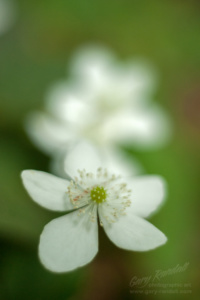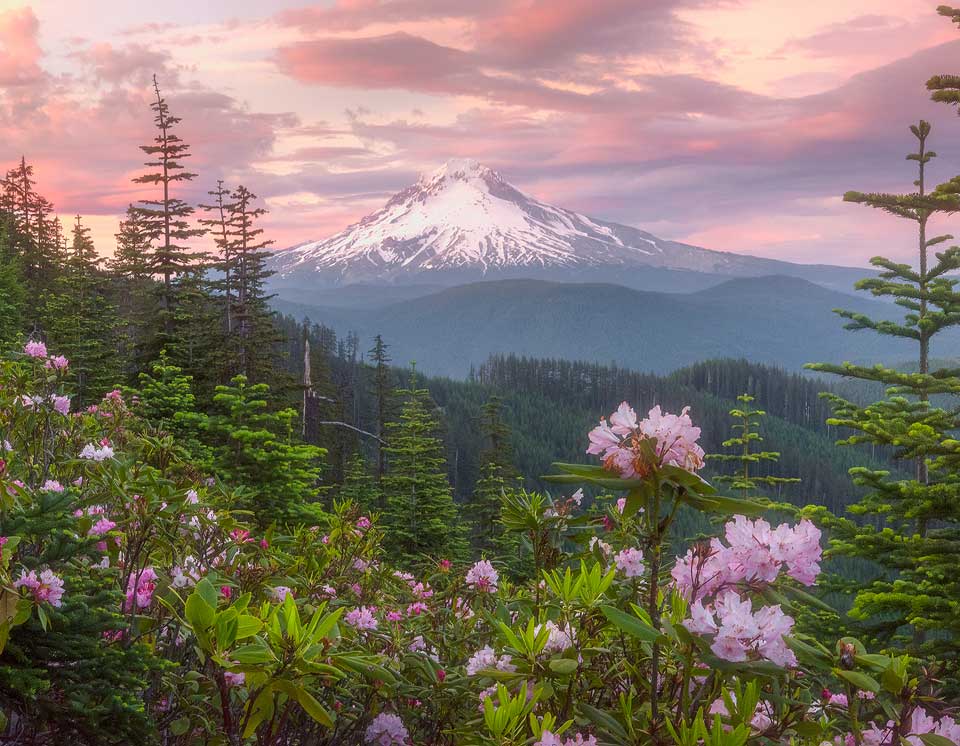Flower Season
Spring has come and gone and now we look forward to Summer here on Mount Hood. Summer on Mount Hood is our best time for wildflowers. Most of the flowers at the lower elevations have come and are starting to go, but our elevation and snow cover delay’s the bloom and gives us amazing flower filled alpine meadows and forests full of native rhododendrons and dogwood trees.

Many landscape photographers wait in anticipation of the Spring Bloom. And because of this a they develop an interest in understanding the cycles of nature including weather patterns and celestial occurrences such as sunrise and sunset times and moon phases. The more one understands nature, the better that they are able to interpret it through their photos.
In the early Spring the flowers at lower, warmer elevations such as the east end of the Columbia River Gorge bloom. Beautiful purple grass Widows are usually the harbinger of Spring in the hills around Hood River and The Dalles, on both sides of the river, and can be seen poking up through coatings of fresh snow some years. Amazing views of the gorge with lupine and balsamroot in the foreground can be had in April and May. The lupine and balsamroot are the larger more visible flowers and will, on a typical year, bloom along side of each other, complimenting each other perfectly, yellow balsamroot and purple lupine.
As the season progresses the flowers move up into the hills and in time to the high altitude alpine meadows of our snow capped peaks. The flowers can cover fields or they can be scattered along roadways. They can even be in your yards. The more that you look for them, the more you notice.

Photographing flowers can be a way to create some beautiful photographs. It can also be a great way to spend some time outdoors. The combination of the two can create a peaceful and centering situation. I can get lost in my own little world as I wander with my wide angle lens among the fields that cover hills or meadows or on my knees with a macro lens in my yard getting close up photos of flowers, mushrooms and bugs.
When I’m out to photograph the grand landscape I try my best to be there either in the morning during a sunrise and into the golden hour or conversely in the evening when the light is nice, but don’t discount a beautiful blue sky especially one with some nice clouds to break up the space. I mention that as an ideal, but the reality is that we live in Oregon and a nice drizzly day can yield beautiful photos as well. On an overcast or cloudy day the light is even and the raindrops on the flowers are beautiful. No raindrops? Use a squirt bottle filled with water to must the flowers.
Let’s talk about the two previously mentioned forms of flower photography, wide angle and macro, or closeup photos. Both forms can be done with any camera.

Let’s first take a look at our cell phones as an option. Taking a nice photo of a field of flowers is pretty simple and the basic tenets of composition apply no matter what kind of camera that you use. While framing your photo tilt the camera up toward the sky or down toward your foreground to make sure that the sky isn’t too bright or the foreground too dark. Turn on your HDR (high dynamic range) setting and turn off your flash unless it’s getting dark and you want to try to illuminate your foreground. Another use for a flash is to shed light on a person especially when you are pointing toward the sunlight. To take a macro photo with your cell phone you can get a clip on macro lens that doesn’t cost much. The lenses usually come in a set. The other lenses in the set I can live without, but the macro lens works reasonably well.
Using a bridge camera, or an all in one non interchangeable lens camera, is handy. The zoom range can go from 24mm to 400mm and some have a fixed aperture of f/2.8 no matter the zoom range. So you can use the zoom in to get close to your subject or zoom out to get the wide view.

A digital SLR (single lens reflex) or even a film SLR, yes you can still use film, can give more options for photographing flowers but the basics, as mentioned previously, still apply. The biggest difference is lens options especially for macro photos. On a SLR you can get a close up photo two ways. One is to put on an extension tube to extend the focal length of one of your prime lenses such as a 50mm, or you can use a longer focal length zoom lens. With an extension tube set up you will be closer to the flower than you could normally get, but it will allow you to fill the frame with the photo and still maintain focus. It’s not so good when you’re photographing bees. The second way is to use a longer focal length zoom lens and zoom in, a much safer way to photograph bees.
Buy a field guide to flowers. It’s fun to identify them. Be a Leave No Trace photographer. While in the field be respectful of the plants around you and try your best to not crush them under your feet. It’s easy to look out away from you while getting the shot and not see the flowers below you.
As always, the technical details mean less than the action of actually getting outdoors with your camera. I may discuss a few minor details about the process but I always stress that it’s less about the process and more about the real reason.


Very beautiful, your work is amazing. I’ve seen a lot of photographers and their work and you are by far the best. Thank you for sharing you talent Gary. I’ve been following you for going on two years now and I’ve posted some of your photos on my profile and mentioned that it’s you that gets the credit. I’ve had so many people comment how they enjoy your work as well. Keep up the great work and maybe one day I will be able to run into you and Darlene I think her name is ?? I’m sorry if I got it wrong. She’s the very beautiful woman you have taken photos of. But I hope to meet you two sometime and chat. Thank you
Thank you sincerely Debbie. I appreciate that very much. Darlene says hello. 🙂
Thank you for caring, Thank you for sharing, Gary.
Gladly Shirley. 🙂